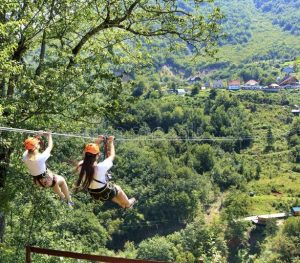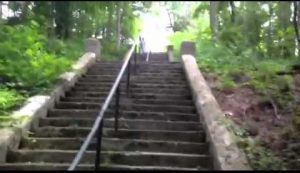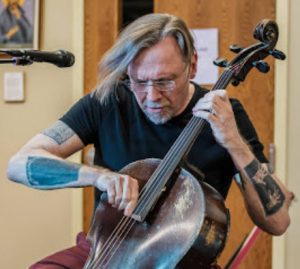Podcast: Play in new window | Download
 Back in the fall of 1987 I was in a camp in mountainous Kingston NY. I was participating in a highly physical course, called the 6-day course, challenging both your body and your fear and what you should do with it. It also added the method of tiny steps that is the secret I want to share in this article.
Back in the fall of 1987 I was in a camp in mountainous Kingston NY. I was participating in a highly physical course, called the 6-day course, challenging both your body and your fear and what you should do with it. It also added the method of tiny steps that is the secret I want to share in this article.
One of the challenges was to cross a valley on a cable stretched, just with your arm’s strength… (Of course I don’t know what it is called, so the pictures are all about zip-lines… oops… what are they called, do you know?)
The first half of the climb was easy… your weight created a slope in the cable… the second part was wicked… you had to, hand over hand, pull your weight over.
It was a lot like mountain climbing: you put one foot in front of the other, and you don’t quit. Small feats take you there.
 I’ll call that method, after Troy, consistent mediocrity… or tiny steps… (Kaizen?)
I’ll call that method, after Troy, consistent mediocrity… or tiny steps… (Kaizen?)
Troy is one of my four coaches. He sent out an email today with the title ‘The boring yet effective simplicity of consistent mediocrity’
I didn’t want to read it, but after finding myself pondering about it, I had to open it.
But I only read the first few lines, because I don’t want to be influenced by what he is saying… I want to say what I want to say.
So what is consistent mediocrity and why is it so darn effective?
Of course it doesn’t praise how most people are… coasting.
Coasting, consistently, is not praiseworthy.
Then what is?
Setting an outlandish goal, carefully to make it something you really value, and then invent one or two actions that allow you, over years, to get there.
How do you do that?
I know this more from observation than from personal experience: instead of keeping the ‘goal’, the outlandish goal, in front of you all the time, as ‘they’ tell you to do, you keep the perfectly crafted actions in front of you.
The context is still the goal, but it is in the background.
It still provides the oomph, it still provides the persistence, but you don’t have to stare at it to see if it is moving, if you are near it, if you are already there.
But, of course, most of us never grew up and we are like those kids in the back seat of the car asking every half an hour ‘are we there yet?’
The art is twofold:
- 1. set the goal such that it is not a whim. it is something that we really want.
- 2. set the action we are going to perform consistently, accurately… meaning it does take us there, and examine it periodically if it is still doing that.
Here are two examples, one is mine, the other one is shared between a client and me.
Mine: I didn’t move all winter. By the time decent walking weather came around, I had so little strength in my body, that taking out the garbage almost killed me.
When I ask people to self-diagnose how healthy they are, one of the question I ask: if you needed to save your life by running a mile away from what threatens it: would you be able to do it?
Most people wouldn’t… and that includes me.
I am 73 years old… but a healthy 73 year old can save their skin by running a mile… instead of burning, drowning, or getting stabbed… in an unpredictable world.
So I decided to get stronger and train to be able to run a mile. Not an ultra marathon 100 miles, not even a normal marathon 40 or so miles, no. A puny mile.
It started with a daily habit of walking down the steps from the second floor and check if I have mail.
Then I added: take the keys with yourself, and step outside of the house.
Then added: walk as far as you can… In the beginning I walked to the next house… and back, and then Fought the fear of dying for a few minutes.
Today I am walking to and around the park, with weights. A few times a week I have added a second time in the afternoon, but without the weights.
I also do a few squats a day.
I never do more than I can, but I can feel that I am getting stronger every day.
I have added another part of the habit: not have anything to eat until I come back from the walk.
Keep the eye on the heroism (consistent mediocrity) of performing this non-heroic habit that will reliably take me to where I want to be: run a mile.
Client’s example:
If you are in business, the most important thing to establish is who is your potential client and what you need to provide that they buy what you offer as a product or service.
You would think that all business owners have this licked, but truth is 90% of business have zero clarity, they are bumbling idiots when it comes to getting new business.
So I have started to implement a checklist I learned from Sean D’Souza, the Brain Audit.
I first bought it in 2016… Many thousands of people have bought it since 2009 when it first came out.
I NEVER implemented it… in spite of its obvious brilliance. I am one of those bumbling idiot businesses…
So yesterday I started to work with this client of mine to implement, step by step, the book and what it teaches… And of course, implement it in my business.
Without it there can be no ‘outlandish’ result. It’s a foundation. You cannot build a skyscraper on a puny, hodge podge foundation.
So we start with the foundation, and make sure that it is sound, it is strong, and it is suitable for a skyscraper.
And keep it in place, strengthen it every step of the way.
Is it consistent mediocrity? I say so. You don’t need to be a nuclear engineer (lol) to implement a simple 7-tier system…
Of course most people throw something together and call it a business, or call it a life.
As you can see, you can bring this principle… nothing major, some simple actions performed consistently can take you anywhere…
No pivoting, no pandering, no chasing the shiny object. The secret of a life well lived, the secret of a high achiever.
Really…
It is not talent… not genius, it is mediocre consistency, or consistent mediocrity that builds empires.
So what should you do now that you have learned that… ok, now that you have heard that.
Look if you can create a big enough, burning enough purpose for yourself to fuel this seemingly no big deal consistent mediocrity at the Vision and Purpose webinar.
You have my support, of course, but you provide the energy.
If you do, I can help you. If you don’t: sorry, I can only guide you, can’t give you MY energy. I need it to live MY life.
My hunch is that I am going to do this webinar more than once.
Why? Because it seems most of you are holding your breath, waiting, so this is not your time yet.
I’ll make sure I get brilliant at the seven areas of the Brain Audit… and invite you again.
But if you are anywhere near ready now, the workshop is scheduled to happen this coming Saturday, at 2 pm. Schedule three hours.
We are creating a vision and purpose for your life…
a lot like people who survived in the Nazi concentration camps, and then went on to have a successful career… and a successful life. Like Victor Frankl, Eli Wiesel, my father, and many more.
No vision? No purpose? Your life can’t be successful, because the context, the backdrop changes with the direction of the wind, the weather, the politics, everything… and that leads to a life that is floundering like a rudderless boat on sea.
The vision and the purpose act as the rudder… Overused metaphor but it’s true.
The consistent mediocrity I spoke of earlier is not sustainable and sustained without a sound vision and purpose. Vision and purpose is the foundation under the foundation.
PS: Wondering why customers don’t buy from you?
Here’s why: in a short video. Watch it to get a sense what the book is teaching. I use the book to coach clients who have or are building a business to crate a sound foundation.
 PPS: I just came back from my walk. There is a jar with beautiful spring flowers in it to say good by to a friend of mine who died this Saturday after climbing the steps to the park where we used to walk together. Heart attack.
PPS: I just came back from my walk. There is a jar with beautiful spring flowers in it to say good by to a friend of mine who died this Saturday after climbing the steps to the park where we used to walk together. Heart attack.
 He was 67 years old. He had circulation issues in his family: he walked and climbed the steps to outlast them, and he did by four years or so.
He was 67 years old. He had circulation issues in his family: he walked and climbed the steps to outlast them, and he did by four years or so.
His personality was to take huge effortful moves… instead of small baby steps. He had contempt and distaste for small insignificant steps… and that is what killed him.
His name was Leo… Don’t be like Leo… come to the Saturday workshop, and maybe you’ll continue in getting some ongoing support from me, so you can build a life that will be good and last a lot longer than 67 years.
